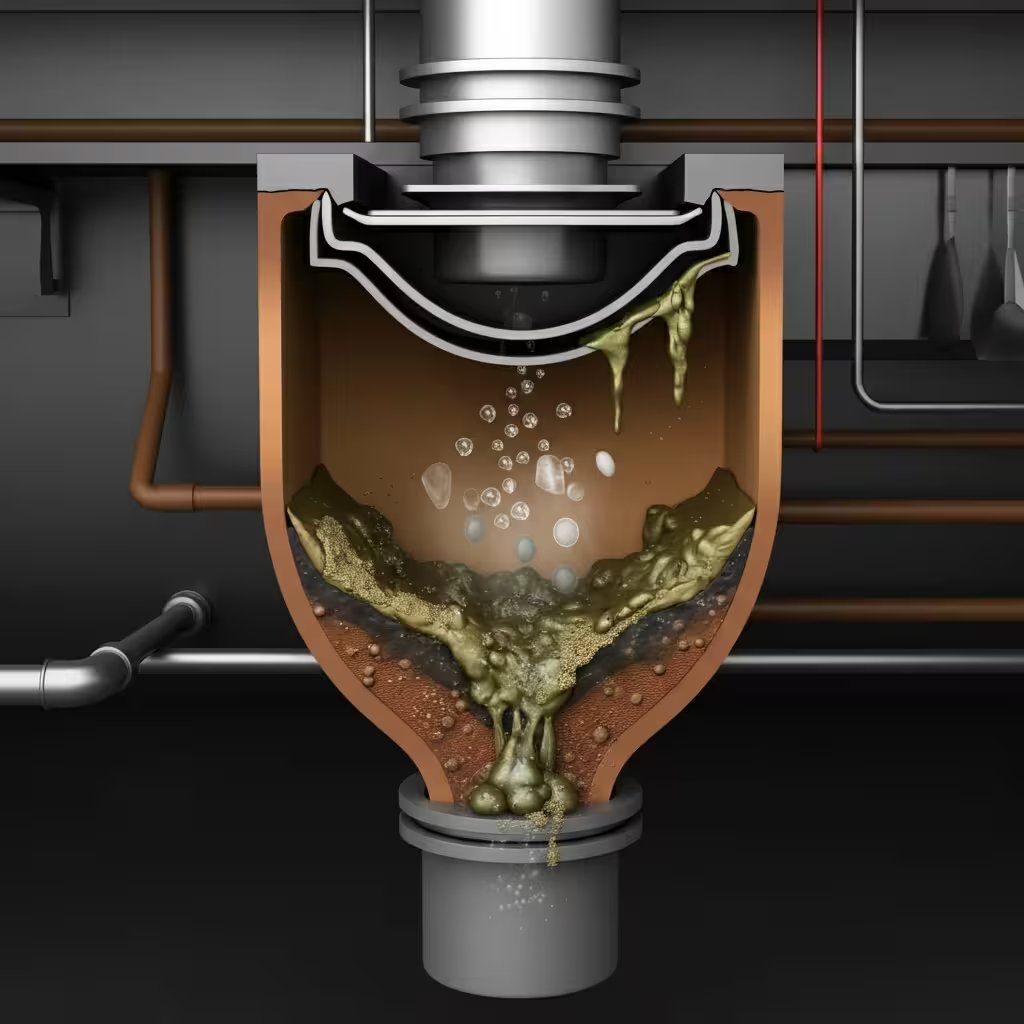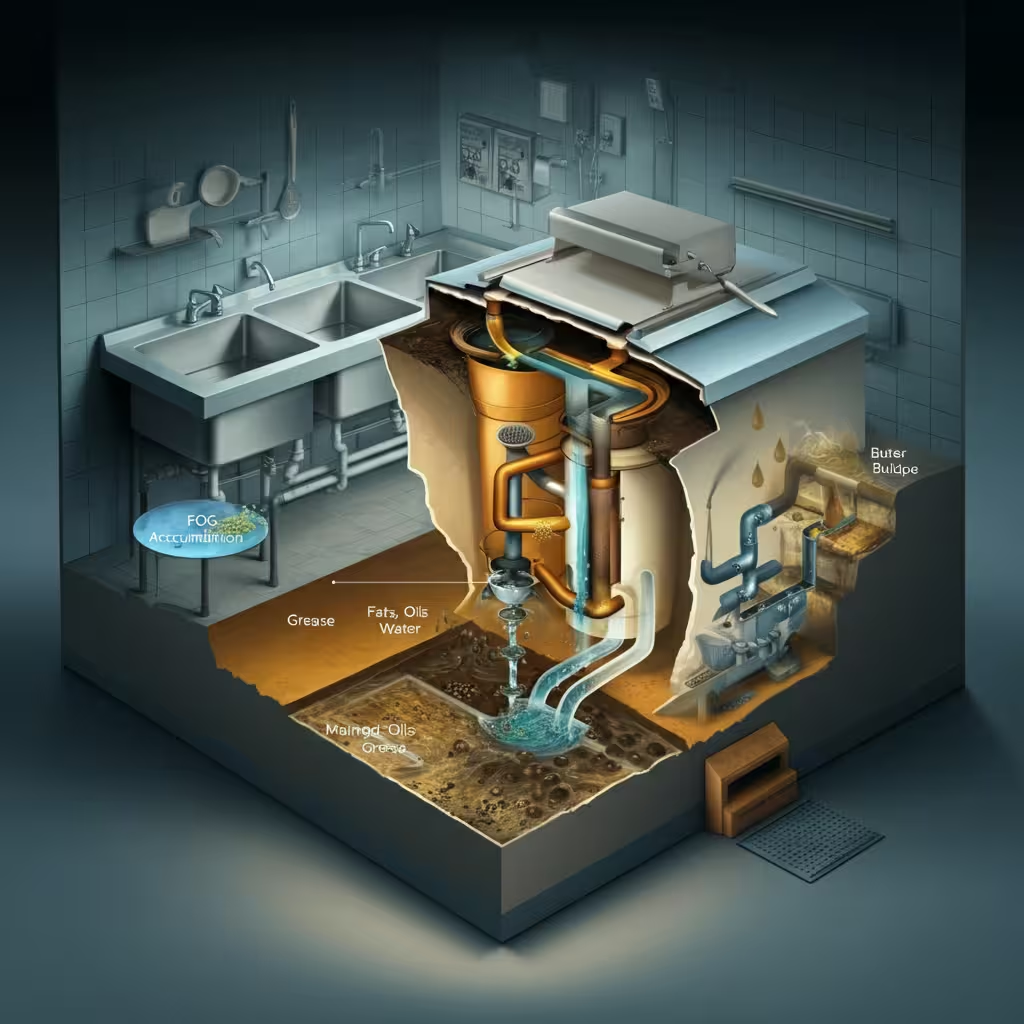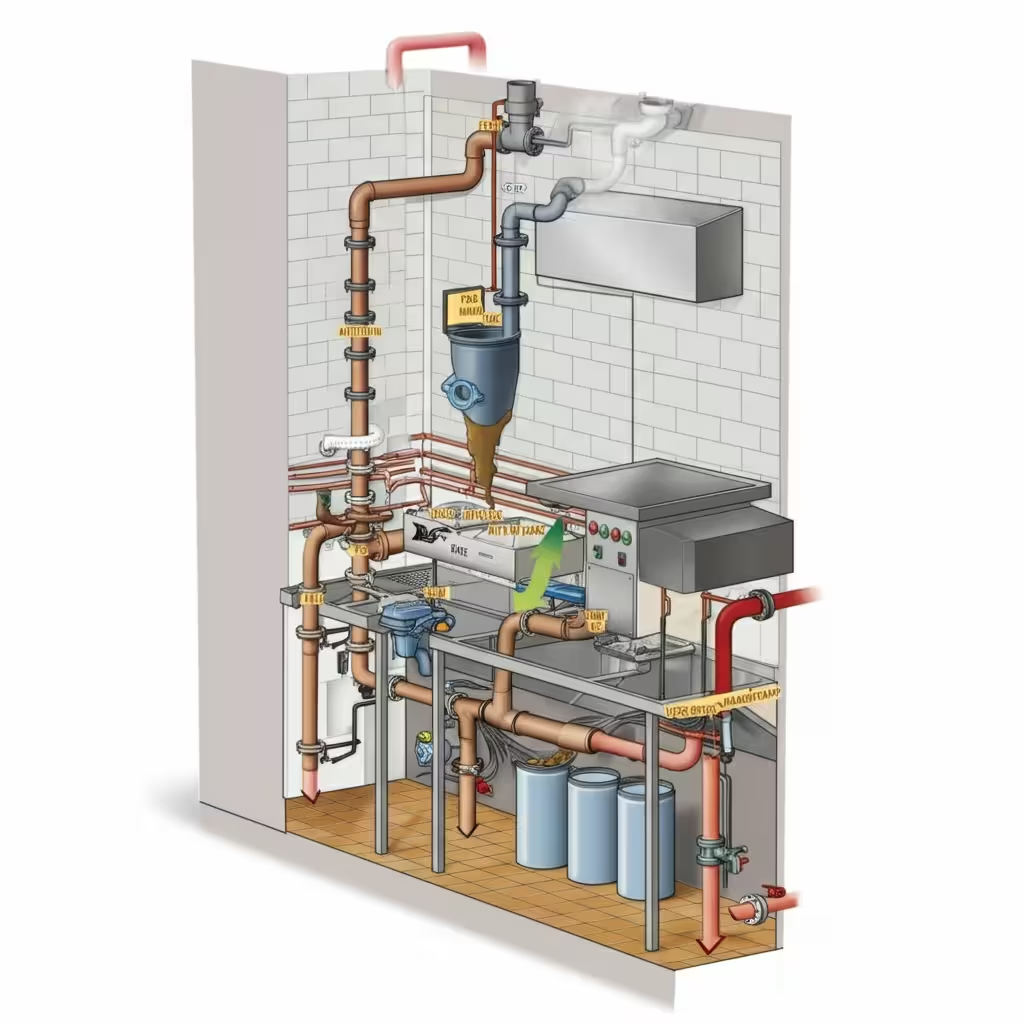You’ve scrubbed every surface, bleached the floors, and aired out the room, but the smell persists. A sulfuric odor or a pervasive sewage smell isn’t just unpleasant—it’s a critical alarm. This kind of foul odor is a clear sign of a significant plumbing or hygiene failure that can jeopardize your health rating, tarnish your reputation, and drive customers away before they even take a bite. When your commercial kitchen smells like sewage, it’s a problem that no air freshener can solve.
This guide will act as your commercial plumbing maintenance diagnostic following code compliance. We will uncover the five primary causes behind that foul smell, from simple fixes to more complex structural issues. Also we had discuss the commercial drain maintenance in our masterclass More importantly, we will provide immediate, professional steps you can take to eliminate the odor for good, protecting your business and ensuring a clean, safe environment for your staff and patrons.
DIAGNOSIS 1: THE DRY TRAP (THE EASIEST FIX)
One of the most common and thankfully simplest reasons a kitchen smells like sewage is a dry P-trap. Every drain in your facility, from sinks to floor drains, is equipped with a P-trap or S-trap. This curved section of pipe is designed to hold a small amount of water at all times. This water acts as a physical barrier, effectively blocking sewer gases—mostly methane and hydrogen sulfide—from flowing up the pipe and into your kitchen.
The Cause: If a particular drain is rarely used, such as a floor drain in a dry storage area or a prep sink that’s out of commission, the water in its P-trap can evaporate. Once the water barrier is gone, there is a direct, open path for sewer gases to escape into your building. This is often the culprit when the foul odor seems to come from a specific, low-traffic area.
The Fix (Quick Action): The solution is as simple as the problem. Pour a bucket of water or a large pitcher of water directly down the affected drain. This will refill the P-trap and immediately restore the water seal, blocking the sewer gas. You should notice the smell dissipating within minutes.
The Fix (Long-Term Prevention): To prevent this from happening again with low-use drains, you need to slow down the evaporation process. After refilling the trap with water, pour a few ounces of a non-volatile liquid like mineral oil, or even standard cooking oil, into the drain. The oil will float on top of the water, creating a film that significantly reduces the rate of evaporation and keeps your P-trap barrier intact for months. Addressing this simple floor drain odor can save you from a lot of unnecessary worry.
DIAGNOSIS 2: THE BLOCKED OR FAILING GREASE TRAP
If the dry trap isn’t the issue, the next and most probable suspect in a commercial kitchen is the grease trap. This device is your frontline defense against fats, oils, and grease (FOG) entering the sewer system, but when it’s not maintained, it becomes a primary source of noxious odors. If your kitchen smells like sewage, your grease trap is the first place a health inspector will look.
The Cause: A grease trap or a larger outdoor grease interceptor works by slowing down wastewater, allowing FOG to float to the top and solid food particles to sink to the bottom. This trapped organic matter begins to decompose almost immediately. When the trap is filled beyond the recommended 25% capacity, or if its internal baffles are damaged, it stops working effectively. The stagnant, rotting FOG and food solids release an intense, overwhelming sulfuric smell. This is not just a bad odor; it’s a sign that your system is failing and a clog is imminent.
The Fix (Intermediate Action): Do not attempt to fix this yourself. The moment you suspect a grease trap smell, you must schedule a professional pump-out. A certified technician will not only remove the FOG and solids but will also scrape the walls and inspect the baffles to ensure the unit is functioning correctly.
The Fix (Long-Term Prevention): A reactive approach to grease traps is a recipe for disaster. Implement a strict scheduled maintenance plan. This includes daily staff checks, manager-level inspections, and a recurring professional pumping schedule based on your kitchen’s volume. Supplement this with a high-quality bio-enzymatic drain cleaner. These solutions use bio-remediation—live bacteria and enzymes—to actively break down FOG and neutralize odors at the source, unlike chemical cleaners that can damage your pipes. This proactive step is key to preventing the situation where your kitchen smells like sewage.

DIAGNOSIS 3: THE BLOCKED VENT PIPE (A STRUCTURAL PROBLEM)
If your traps are full of water and your grease interceptor is clean, but you’re still dealing with foul odors and hearing strange noises, the problem may be above your head. Every plumbing system has a vent stack, a pipe that extends from your sewer line up through your roof. This vent allows sewer gases to escape harmlessly and, just as importantly, allows air to enter the system to equalize pressure.
The Cause: If this plumbing vent stack becomes blocked by leaves, debris, a bird’s nest, or even ice during the winter, your plumbing system can’t “breathe.” This creates negative pressure. When you drain a large sink or flush a toilet, the vacuum created can be strong enough to siphon the water right out of your P-traps. The most common sign of a blocked vent is hearing loud gurgling drain sounds from nearby sinks or floor drains. When the P-trap is siphoned dry, you have an open gateway for sewer gas backflow, and your kitchen smells like sewage as a result.
The Fix (Professional Service): This is not a DIY job. Clearing a main vent stack requires roof access and specialized tools, such as a plumber’s snake or compressed air. A professional plumber can safely access the roof, identify the blockage, and clear the plumbing vent stack without causing damage to your roof or the pipe itself.
Warning: Never allow untrained staff to attempt to clear a vent stack. Working on a roof without proper safety equipment is dangerous, and improper clearing methods can damage the plumbing system. This issue requires a professional diagnosis and solution.

DIAGNOSIS 4: CLOGGED DRAIN LINES AND PIPE BUILDUP
Sometimes, the smell persists even after you’ve cleaned the grease trap and confirmed your P-traps are full. This often points to a deeper issue within the pipes themselves. Over years of use, even with a functioning grease trap, a layer of organic waste and FOG can accumulate on the inner walls of your drain lines.
The Cause: This sticky, thick layer of pipe sludge becomes a permanent food source for anaerobic bacteria. As this bacteria decomposes the waste, it constantly releases hydrogen sulfide gas. The gas can travel back up the pipes and escape through any available opening, causing a persistent problem where your kitchen smells like sewage. Often, an early warning sign is a slow draining sink, which indicates the pipe diameter is narrowing long before the odor becomes severe. If multiple drains are slow, you might be facing a main line clog.
The Fix (The Cure): For this level of buildup, topical cleaners are useless. The most effective solution is commercial hydro-jetting. This process involves using a high-pressure water hose to scour the interior of the pipe completely. The water jets are powerful enough to cut through years of hardened sludge and FOG, restoring the pipe to its original diameter and eliminating the source of the lingering odor.
Prevention: Don’t wait for your drains to clog or for the smell to become unbearable. Incorporating yearly or bi-annual commercial drain cleaning via hydro-jetting into your preventative maintenance plan is the best way to keep your entire system clean, clear, and odor-free. This is the ultimate solution when your kitchen smells like sewage due to internal pipe buildup.
DIAGNOSIS 5: CRACKED PIPES OR FAILED SEALS
The most serious, and thankfully least common, cause of a sewage smell is a physical break in your drainage system. In older buildings, plumbing infrastructure can degrade over time, leading to leaks that release sewer gas directly into your building’s structure.
The Cause: Years of use can lead to pipe corrosion, especially with older cast iron pipes. This can result in cracks or small holes in the drain line. Additionally, the wax rings and seals that connect toilets and floor drains to the plumbing can dry out, crack, or become dislodged. When this happens, sewer gas can escape from under the floor or from behind a wall. This is not just an odor problem; it’s a severe health hazard that can expose your staff and customers to harmful bacteria and gases. If your kitchen smells like sewage and you can’t pinpoint the source, a hidden leak is a strong possibility.
The Fix (Inspection): You cannot diagnose this problem visually. The only way to confirm a cracked pipe or failed seal is with a professional sewer camera inspection. A technician will feed a flexible, high-resolution camera through your drain lines to get a real-time view of the pipe’s interior. This allows them to visually identify the exact location of any cracks, leaks, root intrusion, or collapsed sections.
The Solution: Depending on the findings of the camera inspection, the solution could range from a targeted pipe repair to a full replacement of the damaged section. Addressing a cracked drain line is a critical repair that must be handled by a licensed professional to ensure it’s done correctly and safely.
CONCLUSION: THE BREATH OF FRESH AIR
When your commercial kitchen smells like sewage, it’s your building’s way of telling you something is seriously wrong. Relying on air fresheners or ignoring the problem will only lead to more significant issues, including potential health code violations, costly emergency repairs, and lost business. The sewage smell almost always points to one of the five issues discussed above, most of which are rooted in FOG management, proper venting, and drain line integrity.
Ready to eliminate the smell for good and protect your health rating? Don’t let a foul odor compromise your business. Contact FOG Control Solution today. We specialize in keeping restaurant plumbing compliant and odor-free. Let us schedule your sewer camera inspection and develop a customized commercial drain maintenance plan that addresses the root cause of the problem. We are your reliable and professional partner in ensuring your kitchen is clean, safe, and welcoming.
FREQUENTLY ASKED QUESTIONS (FAQs)
Q1: Why does the sewage smell get worse when I run the dishwasher?
This is often a sign of a partial clog or a blocked vent pipe. The large, sudden discharge of water from a commercial dishwasher overwhelms the restricted drain line, forcing sewer gases up through other nearby drains. It can also create a siphon effect that empties P-traps.
Q2: Can a sewage smell in the kitchen be harmful to my employees?
Yes. Sewer gas contains hydrogen sulfide, methane, and other volatile organic compounds. In low concentrations, it causes an unpleasant odor. In higher concentrations, it can lead to headaches, dizziness, and nausea. A persistent sewage smell indicates a plumbing failure that is a potential health hazard.
Q3: I had my grease trap pumped, but my kitchen still smells like sewage. What’s next?
If a clean grease trap doesn’t solve the problem where your kitchen smells like sewage, the next steps are to check for dry P-traps in unused drains and then investigate deeper issues. The most likely culprits are a blocked plumbing vent on the roof or significant sludge buildup in the main drain lines, which would require professional hydro-jetting.
Q4: How can I tell if the smell is from a plumbing issue or just spoiled food?
A smell from spoiled food is typically localized to a trash can or a specific area and dissipates once the source is removed. A sewage smell is more pervasive, often described as sulfuric or like rotten eggs, and it persists even after thorough cleaning. It may also seem to emanate from the drains themselves.
Q5: Is a sewer camera inspection expensive?
While there is a cost to a sewer camera inspection, it is far less expensive than the alternative. It provides a definitive diagnosis, preventing you from spending money on incorrect repairs. More importantly, it can save you from the massive costs associated with an emergency shutdown, lost revenue, and extensive water damage from a complete line failure. It’s a critical investment when your kitchen smells like sewage and the cause is not immediately obvious.

